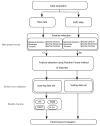EMD-Based Method for Supervised Classification of Parkinson's Disease Patients Using Balance Control Data
- PMID: 35877334
- PMCID: PMC9311556
- DOI: 10.3390/bioengineering9070283
EMD-Based Method for Supervised Classification of Parkinson's Disease Patients Using Balance Control Data
Abstract
There has recently been increasing interest in postural stability aimed at gaining a better understanding of the human postural system. This system controls human balance in quiet standing and during locomotion. Parkinson's disease (PD) is the most common degenerative movement disorder that affects human stability and causes falls and injuries. This paper proposes a novel methodology to differentiate between healthy individuals and those with PD through the empirical mode decomposition (EMD) method. EMD enables the breaking down of a complex signal into several elementary signals called intrinsic mode functions (IMFs). Three temporal parameters and three spectral parameters are extracted from each stabilometric signal as well as from its IMFs. Next, the best five features are selected using the feature selection method. The classification task is carried out using four known machine-learning methods, KNN, decision tree, Random Forest and SVM classifiers, over 10-fold cross validation. The used dataset consists of 28 healthy subjects (14 young adults and 14 old adults) and 32 PD patients (12 young adults and 20 old adults). The SVM method has a performance of 92% and the Dempster-Sahfer formalism method has an accuracy of 96.51%.
Keywords: Parkinson’s disease; feature extraction; feature selection; machine learning; postural stability; stabilometric data.
Conflict of interest statement
The authors declare no conflict of interest.
Figures



References
-
- Mergner T., Maurer C., Peterka R. A multisensory posture control model of human upright stance. Prog. Brain Res. 2003;142:189–201. - PubMed
-
- Mohebbi A., Amiri P., Kearney R.E. Contributions of Vision in Human Postural Control: A Virtual Reality-based Study; Proceedings of the 2020 42nd Annual International Conference of the IEEE Engineering in Medicine &Biology Society (EMBC); Montreal, QC, Canada. 20–24 July 2020; Piscataway, NJ, USA: IEEE; 2020. pp. 3347–3350. - PubMed
LinkOut - more resources
Full Text Sources

